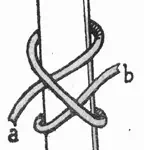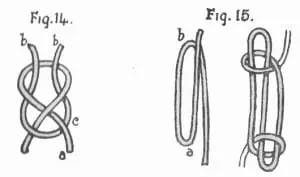Rope Knots
For the average person who only occasionally uses rope knots, it is helpful to learn a few knots which are easy to remember. These should also be easy to tie, strong, secure and safe for various purposes. Be prepared to tie secure knots and easily undo them when needed. Learn a few good knots and practice them.
Half Hitch
Pass the rope’s end around standing part b and through the bight (Fig 6).

Figure 6
Clove Hitch
Pass the end around a post and cross it over b (Fig 7). Pass around the post again, and put (a) through the second bight (Fig 8). Two Half Hitches tied around an object.
Timber Hitch
Pass the end around a post (Fig 10), then around the standing part b, then three or four times around its part c.
Sheep’s Shank
Take bight as shown in Fig 15. half hitch over ends (a) and (b) with ends.
Some excellent old rope knots books
1. Knots, Splices and Ropework, by Hyatt Verrill written in 1917, 80 pages. “Giving complete and simple directions for making all the most useful and ornamental knots in common use, with Chapters on Splicing, Pointing, Seizing, Serving, etc. Adapted for the use of travellers, campers, yachtsmen, Boy Scouts, and all others having to use or handle ropes for any purpose.”
2. The Use Of Ropes and Tackle, by H.J. Dana and W.A. Pearl, 1922, 75 pages.”Various knots and splices are shown, with occasional suggestions for their use and application. Some knots tie easily and are very secure but are not so easy to untie; others are easily and quickly tied- are secure and yet are not difficult to untie. Some knots are suitable for small cords only, and others are adapted to large ship’s hawsers. For these and other reasons, it is desirable to select the right knot for the job in hand.”





